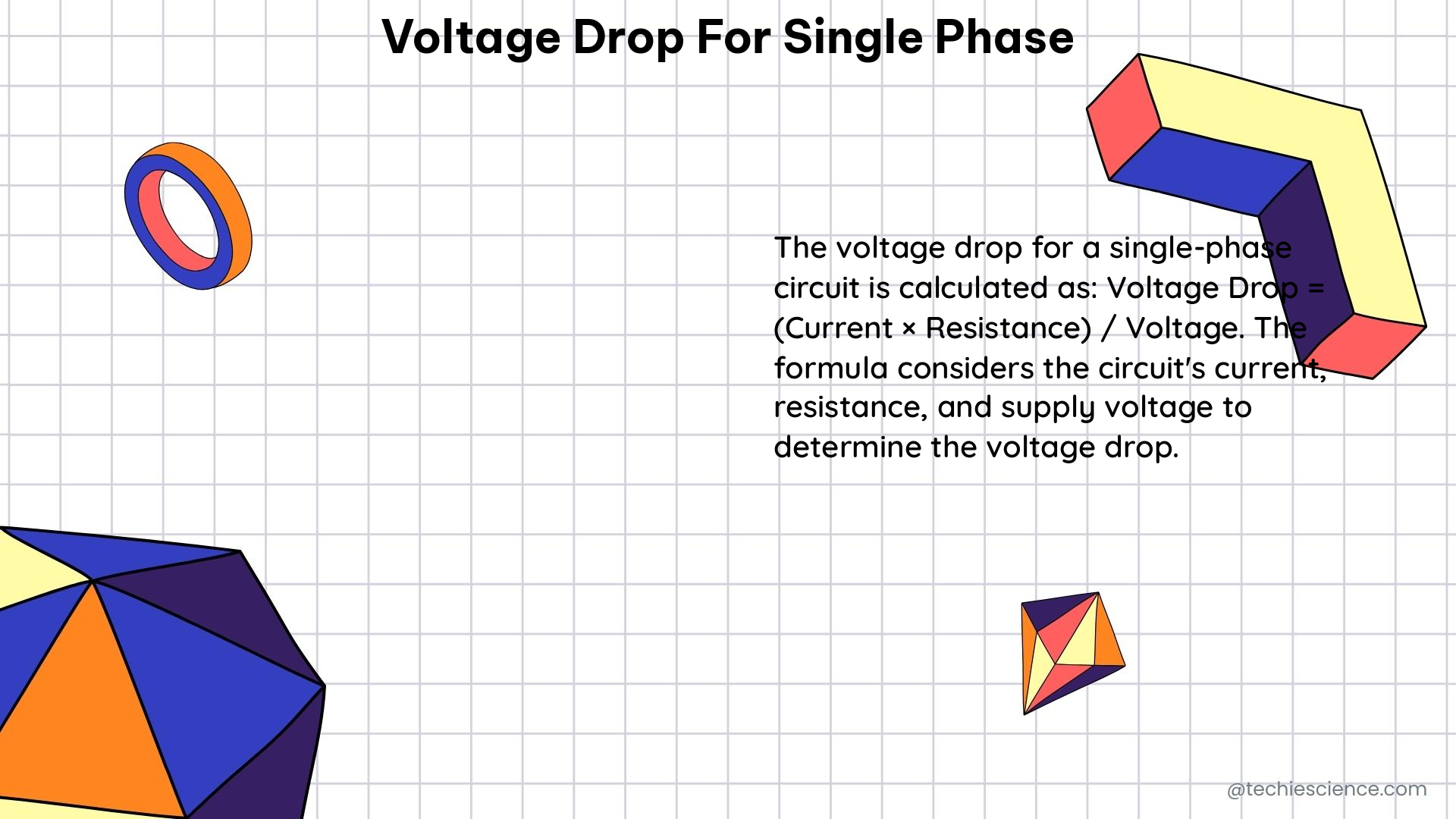Voltage drop in a single-phase circuit is a critical consideration in electrical system design, as it can significantly impact the performance and efficiency of the connected devices. Understanding the factors that contribute to voltage drop and the methods for calculating it is essential for ensuring proper operation and compliance with electrical codes and standards.
Understanding Voltage Drop in Single-Phase Circuits
Voltage drop in a single-phase circuit is the decrease in voltage between the source and the load due to the resistance of the wires carrying the current. This voltage drop can lead to a reduction in the voltage available at the load, which can cause issues with the proper operation of electrical devices.
The voltage drop in a single-phase circuit can be calculated using the formula:
Vd = (I x L x R) / 1000
Where:
– Vd is the voltage drop in volts
– I is the current in amperes
– L is the length of the wire in meters
– R is the resistance of the wire in ohms per kilometer
Factors Affecting Voltage Drop

The resistance of the wire, which is a key factor in the voltage drop calculation, depends on several variables:
-
Wire Material: The most common materials used for electrical wiring are copper and aluminum. Copper has a lower resistance per unit length compared to aluminum, making it a more efficient conductor.
-
Cross-Sectional Area: The cross-sectional area of the wire, measured in square millimeters (mm²), also affects the resistance. Larger cross-sectional areas have lower resistance, resulting in lower voltage drop.
-
Temperature: The resistance of a wire increases as the temperature increases. The resistance values provided in this guide are based on a temperature of 20°C (68°F).
-
Length of the Wire: The longer the wire, the greater the voltage drop, as the resistance increases with the length of the wire.
-
Power Factor: The power factor, which is the ratio of the real power to the apparent power, can also affect the voltage drop calculation. The formula for voltage drop considering the power factor is:
Vd = (I x L x R x Pf) / 1000
Where Pf is the power factor.
Resistance Values for Common Wire Sizes
The resistance of copper and aluminum wires at 20°C (68°F) can be found in the following tables:
Copper Wires at 20°C (68°F)
| Wire Size (mm²) | Resistance (Ω/km) |
|---|---|
| 1.5 | 0.0178 |
| 2.5 | 0.0068 |
| 4 | 0.0037 |
| 6 | 0.0024 |
Aluminum Wires at 20°C (68°F)
| Wire Size (mm²) | Resistance (Ω/km) |
|---|---|
| 2.5 | 0.0274 |
| 4 | 0.0137 |
| 6 | 0.0091 |
Voltage Drop Limits and Regulations
The National Electrical Code (NEC) recommends a maximum voltage drop of 5% for the entire electrical system, including the service drop and branch circuits. However, some local building codes, such as the Florida Building Code (FBC Chapter 13), mandate a more stringent limit of 3% on branch circuits (2% service drop/3% branch drop or reverse, according to the local inspector).
Measuring Voltage Drop
To measure the voltage drop across just the branch circuit wires, with no load connected, you can use a voltage drop calculator like the one provided by Southwire. This calculator allows you to input the conductor size, circuit distance, phase, current, power factor, and units for length of cable run to calculate the voltage drop.
When using a voltage drop calculator, it’s important to ensure that the input values accurately reflect the actual electrical system. Factors such as wire size, length, and power factor can significantly impact the calculated voltage drop.
Practical Examples and Calculations
Let’s consider a few practical examples to illustrate the voltage drop calculations for single-phase circuits:
- Example 1: A single-phase circuit with the following parameters:
- Current (I): 20 A
- Wire Length (L): 50 m
- Wire Size: Copper, 2.5 mm²
- Power Factor (Pf): 0.85
Voltage drop calculation:
Vd = (I x L x R x Pf) / 1000
Vd = (20 x 50 x 0.0068 x 0.85) / 1000
Vd = 5.78 V
In this example, the voltage drop is 5.78 V, which is within the NEC’s recommended 5% limit but exceeds the 3% limit set by the Florida Building Code.
- Example 2: A single-phase circuit with the following parameters:
- Current (I): 15 A
- Wire Length (L): 30 m
- Wire Size: Aluminum, 4 mm²
- Power Factor (Pf): 0.90
Voltage drop calculation:
Vd = (I x L x R x Pf) / 1000
Vd = (15 x 30 x 0.0137 x 0.90) / 1000
Vd = 3.69 V
In this example, the voltage drop is 3.69 V, which is within both the NEC’s 5% recommendation and the Florida Building Code’s 3% mandate.
These examples demonstrate the importance of considering the various factors that contribute to voltage drop, such as wire material, cross-sectional area, length, and power factor, to ensure compliance with electrical codes and standards.
Conclusion
Voltage drop in single-phase circuits is a critical consideration in electrical system design. By understanding the factors that contribute to voltage drop and the methods for calculating it, electrical professionals can ensure that the voltage at the load is sufficient for the proper operation of devices, while also meeting the requirements of electrical codes and standards.
References
- Voltage Drop Calculation Question
- Voltage Drop: Definition & Calculation
- Measure Voltage Drop with No Load at All
- Southwire Voltage Drop Calculator

Hi……I am Kaushikee Banerjee completed my master’s in Electronics and Communications. I am an electronics enthusiast and am currently devoted to the field of Electronics and Communications. My interest lies in exploring cutting-edge technologies. I’m an enthusiastic learner and I tinker around with open-source electronics.